Motza mosaicists: Putting an ancient Roman mosaic floor back together

Residents of a village near Jerusalem piece together an ancient Roman floor.
You want to dig a hole in the ground to plant or bury something, perhaps lay the foundation for a road or a new building? Think again. In Israel, there’s usually more to it than simply picking up a spade. This country has been inhabited for thousands of years, and chances are high that your spade will hit an ancient ruin and transform your garden or plot into an archaeological site. Before starting, you will need to get a license from the Israel Antiquities Authority (IAA).
The route to Jerusalem from the coastal plain has for centuries been a major artery, with traffic increasing every year. In modern times, safety measures were introduced to prevent road accidents, and work on the project of Highway 1 began a few years ago. The final section of Highway 1, taking the traveler into the capital, starts with a steep climb at the Motza junction. In the nearby valley, there are springs and a confluence of two stream beds – Nahal Sorek and Nahal Arza. With its plentiful supply of fresh water, there has always been human habitation in Motza; remains of prehistoric settlements have been found dating back to 8,600 BCE.
Rescue excavation of the ancient sites was needed. In 2012, the Tel Motza Temple was unearthed, and the excavation site took on a new significance. The remains of several buildings were found near the temple, as well as a cache of ritual objects that included ceramic figurines of humans and animals. From the temple site came a rare find of remains from the First Temple period; widening the highway would have destroyed the site. It was an issue of road safety versus antiquities conservation. The answer came with the construction of two bridges raised on massive pillars. At 700 meters, they are the longest bridges in the country, built to accommodate the two lanes of traffic. The pillars were carefully placed to protect the site and the streams below.
The excavations
The Tel Motza team of archaeologists have completed most of their field work, removing the antiquities and filling in and covering the excavated areas. Traffic now flows smoothly to Jerusalem along the bridge, high above the sharp bend in the road at the Motza junction. The Neolithic, Iron Age, and Bronze Age finds are being examined and studied; peace has returned to Motza. The inhabitants, many of whom had taken part in the digs, were hoping that some memento would remain in the village. However, the IAA declared that the artifacts are of national importance, to be held by and eventually displayed in the Israel Museum.
The solution to this dilemma came from the Roman artifacts found nearby. Some 50 meters up the hill, on the winding Seven Sisters Road, is the village of Motza Ilit (Upper Motza), founded by Jews in the early 20th century above Old Motza (Lower Motza). Originally a Roman town known as Colonia (after which the Arab village Qalunya was named), a garrison of 800 Roman soldiers was settled there by emperor Vespasian in 71 CE.
In the vicinity of the prehistoric Tel Motza Temple site, several Roman-Byzantine mosaic floors had been found, almost intact, splendid examples of Roman artwork. These were carefully removed to be examined and restored by experts at the Rockefeller Museum in Jerusalem.
The history of the mosaic art form began in the 5th century BCE, initiated by the Greeks. Pebbles were embedded into a bed of mortar, creating pieces of artwork to be placed in the home. The Romans then went on to develop the craft, using small pieces of stone, fragments of glass, marble, brick, pottery, and other natural materials from which they created portraits, pictures of humans and animals, scenes from mythology and history, large-scale works for floors, and smaller decorative pieces. As the Roman Empire expanded across Europe and North Africa, mosaic art developed, spreading over the Mediterranean area, with sweeping landscapes and grandiose ceiling displays in palaces, churches, and mosques, many of which remain to this day.
Shauli Yossefon is a Motza resident with a particular interest in mosaics. He studied in Ravenna, Italy, the world center of mosaic art, and now teaches in Motza. Naturally, he was thrilled that genuine Roman mosaics had been found not far from his own home, near the Seven Sisters Road. He described his feelings when he saw the finds:
“I was amazed at their beauty, at the cultural and economic wealth they represent. I wanted to bring something of this treasure to our community so that we would have a connection with the history and the archaeology of the place where we live. The Roman mosaic floor that I chose was found in Motza, in a garden near a modern house. I fell in love with it because of the image of the partridge, a local bird, and what it signifies. My guess is that the Roman owner of the mosaic loved the nature all around his home. Because we were not able to keep the original, and because I enjoy making ancient mosaic replicas, I gathered a group of neighbors, and with the support of the local community, we launched a project to create a replica of the Motza mosaic that would remain forever in the village.”
Yossefon infected Motza residents with his enthusiasm. Before the original mosaic (measuring 1.60x1.60 meters) was transferred to the Rockefeller Museum, Yossefon scanned it, producing a high-quality image on paper. He attached it to a large table in his studio, covering it with a strong transparent net fabric, all to be removed later. Then he collected the materials for the job – blocks of stone from nearby fields, black, brown, white, green, red – which he and the team cut into neat cubes and strips. These are called tesserae, some tiny, others larger, following the size and colors of the Roman original. The pieces are durable and do not fade, giving mosaic art its nickname “eternal pictures.”
On Friday mornings, the Motza mosaicists, I among them, gathered around the table and got to work on the replica, chipping and glueing in true Roman fashion. Supervised by Yossefon, we chose tesserae that matched the original in color and size. Daubed with glue on one side, each piece was carefully attached to the net. The central panel of a Roman mosaic, surrounded by its a decorative patterned frame, is called in Italian an emblamata mosaico. It is the highlight of the work, in this case the portrait of a bird. Part of the frame was missing in the original.
This was added to the replica by copying from another part of the mosaic. Yossefon suggested that as a final touch, we might add an inscription on the bottom edge of the replica. After further discussion, we agreed on an international text to be inscribed on the four sides of the mosaic – “EMBEDDED WITH LOVE BY MOTZA COMMUNITY, 2023” – written in the languages spoken in Israel today (Hebrew and Arabic) and in languages spoken internationally, English today, and Latin in the days of the Roman Empire. For translation, native speakers of Hebrew and English were on hand. An Arab family living in Motza joined us to translate into Arabic, and a professor of classical languages provided the Latin. The Friday meetings continued for six months until the work was completed, producing an authentic reproduction of the ancient mosaic. On Friday, February 10, the last of the tesserae were inserted. The replica mosaic was complete, and a toast was raised.
The next task was to prepare the site. For our next meeting, we were instructed to bring spade and shovel and wear sturdy work clothes. A suitable shady spot in the center of the village chosen by Yossefon had been approved by the village committee. The ground was leveled and cleared, and the paving was laid. The mosaic brought from Yossefon’s studio on a wheeled trolley was attached to an iron frame, its final home. Thoroughly cleaned with a stiff broom and a high-pressure stream of water to remove the paper, the net, the glue, and the accumulated dirt, the mosaic was finally veiled in a heavy blue cloth until the following morning.
Friday, February 23, was a day of celebration. Our team of Motza mosaicists welcomed the villagers to the dedication ceremony. Deeply moved, Yossefon, assisted by his family, unveiled the mosaic, thanking the many people who had contributed to the project, supporting him in the creation of the Motza Mosaic replica. It was a moment of general rejoicing, a feeling that something important had been accomplished.■
Jerusalem Post Store
`; document.getElementById("linkPremium").innerHTML = cont; var divWithLink = document.getElementById("premium-link"); if (divWithLink !== null && divWithLink !== 'undefined') { divWithLink.style.border = "solid 1px #cb0f3e"; divWithLink.style.textAlign = "center"; divWithLink.style.marginBottom = "15px"; divWithLink.style.marginTop = "15px"; divWithLink.style.width = "100%"; divWithLink.style.backgroundColor = "#122952"; divWithLink.style.color = "#ffffff"; divWithLink.style.lineHeight = "1.5"; } } (function (v, i) { });

